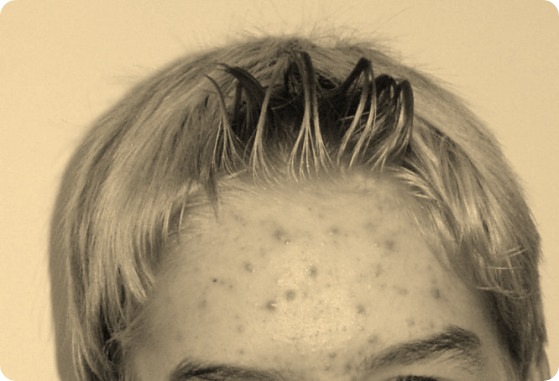Acne vulgaris (commonly called acne) is a common skin condition, caused by changes in pilosebaceous units, skin structures consisting of a hair follicle and its associated sebaceous gland, via androgen stimulation. It is characterized by noninflammatory follicular papules or comedones and by inflammatory papules, pustules, and nodules in its more severe forms. Acne vulgaris affects the areas of skin with the densest population of sebaceous follicles; these areas include the face, the upper part of the chest, and the back. Severe acne is inflammatory, but acne can also manifest in noninflammatory forms. Acne lesions are commonly referred to as pimples, blemishes, spots, zits, or simply acne.
Acne is most common during adolescence, affecting more than 89% of teenagers, and frequently continues into adulthood. The cause in adolescence is generally an increase in male sex hormones, which people of both genders accrue during puberty. For most people, acne diminishes over time and tends to disappear - or at the very least decrease - after one reaches one's early twenties. There is, however, no way to predict how long it will take to disappear entirely, and some individuals will carry this condition well into their thirties, forties and beyond.
 |
The face and upper neck are the most commonly affected, but the chest, back and shoulders may have acne as well. The upper arms can also have acne, but lesions found there are often keratosis pilaris, not acne. Typical acne lesions are comedones, inflammatory papules, pustules and nodules. Some of the large nodules were previously called "cysts" and the term nodulocystic has been used to describe severe cases of inflammatory acne.
Aside from scarring, its main effects are psychological, such as reduced self-esteem and, according to at least one study, depression or suicide. Acne usually appears during adolescence, when people already tend to be most socially insecure. Early and aggressive treatment is therefore advocated by some to lessen the overall impact to individuals.
Though it's often portrayed as a scourge of the teen years, acne can affect people of all ages. According to the National Institutes of Health (NIH), about 80 percent of people between the ages of 11 and 30 have outbreaks of the skin disorder at some point. "Many see their acne go away by the time they reach their 30s," says Jane Liedtka, a medical officer at the Food and Drug Administration's (FDA) Center for Drug Evaluation and Research (CDER). "But for some, acne persists into their 40s and 50s."
source : http://www.news-medical.ne




No comments:
Post a Comment